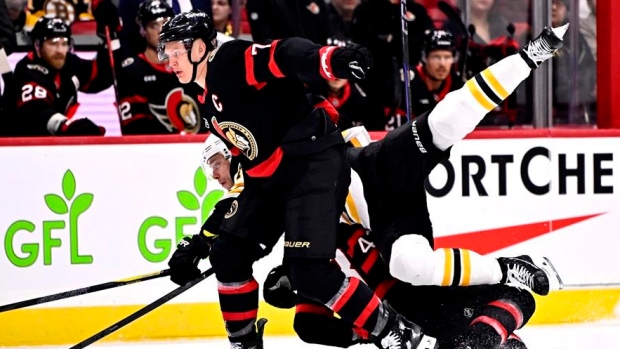Analysis: Staios Shakes up the Sens' Core in Swapping Norris for Cozens
Steve Staios shakes up the Sens' core and makes a bet on another team's underachiever

Heading into the 2025 Trade Deadline, the Ottawa Senators didn't look from the outside to be likely to be major players. But if there's one thing that's clear about Steve Staios by now, it's that, unlike his predecessor, his front office doesn't leak. So maybe we shouldn't have been quite so surprised that the Sens' GM had a major shake-up in the works:
Although Staios has made some not-insignificant changes to the roster, dealing Josh Norris represents the first changing of the "core" as most people would understand it. If it wasn't the case before, this team is now firmly shaped in Staios' image. He's seen what this group was capable of, and found it wanting.
As for the particulars of this deal, there's a lot to chew on here. On the surface, this is a case of two teams swapping underperformers and hoping that a change of scenery will cure what ails each of them. Dylan Cozens plays a different style of game from Norris, but his career arc is remarkably similar. Both are former 1st round picks who had breakout campaigns in their third year in the league, signed big money, long-term deals, and have being struggling to live up to the accompanying price tag and expectations ever since. You don't have to squint too hard to see what both the Sens and Sabres are thinking here: "Maybe we can fix him." From Ottawa's perspective, Cozens certainly wouldn't be the first former Sabre to have a glow-up away from Buffalo.
Beyond the superficial similarities, though, these are two very different players. Norris is a great finisher and a strong skater who plays a defensively responsible game, but who struggles to distribute and move the puck up ice. He's a goal-scorer who does most of his damage on the power-play, where he can wait in a power position to unleash his formidable shot. Ultimately, though, Norris' production and play-driving at 5v5 has never quite been where it needed to be to justify his role or the money he is being paid. There's a reason that you would periodically hear his name being bandied about as trade-bait over the last 18 months or so.
Cozens, on the other hand, loves to carry the puck and can help create offense for himself and his linemates – particularly off the rush. He's not the same quality of skater as Norris, but instead uses his big frame to hold onto the puck and find passing lanes to create dangerous attacking opportunities. He'll attack, and beat, defenders one-on-one. All-in he's a much more traditional play-making centre. Speaking of Staios putting his mark on the team, Cozens stands at 6'3 – definitely not a coincidence based on what we know about the GM's preferences.
Two years ago, Cozens looked like a potential top line guy of the Jordan Kyrou mold. He's stagnated since. Guess we'll see if a fresh start helps. pic.twitter.com/MdLwKoCFgB
— Corey Sznajder (@ShutdownLine) March 7, 2025
There's more to this trade than just the on-ice play of the two principals, though. As aforementioned, both Norris and Cozens are just getting started on long-term deals. Cozens' deal is a bit cheaper at $7.1MM AAV, but he's also signed until 2030. If the Norris contract was viewed as an anchor by the Sens, Cozens' deal almost certainly carried just as much, if not more, negative value. That Ottawa was able to extract a 2026 second round pick as part of the package suggests that Norris was, in fact, viewed as the better asset – even on his current deal.
The importance of chemistry is often overstated, but it would be foolish to totally dismiss the impact of trading a popular player like Norris could have on the locker room. Norris is a long-time friend of Brady Tkachuk, and the captain was emotional in discussing the deal earlier today:
Maybe Cozens will one day be beloved in the room, and if the Sens make a run to the post-season perhaps this is all forgotten by April, but I'm sure that Staios must have thought long and hard about whether the swap was worth the emotional turmoil.
There was more to this trade than just swapping Norris and Cozens and the second round pick, though. Moving on from Jacob Bernard-Docker affords the UND grad the opportunity to crack an NHL line-up. JBD's role had been marginalized this season with Nicolas Mantipalo' ascendance. After nearly seven years in the Sens' organization, I'm mostly happy that he's getting another opportunity to prove himself.
With Tyler Kleven out "week-to-week", acquiring the left-handed shooting Dennis Gilbert makes some sense as a stop gap. That said, Gilbert is not someone that you want playing a meaningful role on your team if the goal is to make the play-offs:

I would be surprised if he has a long-term future in the organization, but look to Gilbert to hold down a spot on the third pair until Kleven returns.
In the end, this trade is premised on the bet that Cozens can be something close to the 2022-23 version of himself when he potted 31 goals and 68 points in 81 games as a 21 year-old. The fact that he's only 24, a full two years younger than Norris, makes that a very real possibility. At the very least, Ottawa must feel confident Cozens is more likely than Norris to be in the line-up on a regular basis given the latter's spat of shoulder injuries. That's not nothing: Norris' long-term future in the league will always be a bit of a question mark. But it's also not a given that this trade will automatically improve the team's fortune because Cozens has not obviously been any better than Norris this year, and he's nearly as expensive. This is an educated gamble on the part of Staios. If it pays off, he could look very smart indeed. If Cozens' struggles continue, though, his name might be the one we're all hearing in trade rumours in a couple of years' time.





